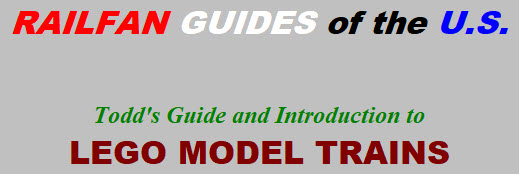
In General
the Basics of Building with Lego Blocks
Lego Parts - "Regular" Elements
Lego Parts - Technic
Lego Trains
Non-Lego Trains
Stations and Accessories
Signals, Bridges, and Tunnels
Floobydust
RAILROAD SIGNALS HOME
After seeing Lego trains at a number of local train shows, I always thought they looked kinda neat, and finally gave in to the urge and took the plunge.
For the most part, Lego is not into producing engines and freight cars that you might want to run in a realistic freight train consist. For that, you have to go to the third party vendors and manufacturers. Lego today produces mostly European style three car intercity commuter train sets - most of which come with figures, stations, and accessories.
For now (early 2023), Lego produces motorized trucks, track sections, and switches, in addition to a few train sets, or kits, mostly as part of their "City" collection series.
As of the beginning of November 2023, Lego announced it would be discontinuing many part offerings in their "pick a part" part of their website. It looks like the majority of parts affected will be farm animals, and minifig components. See below for one notice featured on Jay's Brick Blog. Additionally:
https://rebrickable.com/users/TobyMac/lists/53125/ has 21 pages of parts being discontinued :-(
https://www.newelementary.com/p/lego-pick-brick-retiring-parts.html
 I
can't believe they are not going to make these available anymore....
I
can't believe they are not going to make these available anymore....If you want to get started with Lego Trains, a good place to start is the "L-Gauge Modular System" website, which gives you background info, upcoming shows, and standards to adhere to if you want to build a module and have it connect into other modules at shows. Everyone I have talked to so far at shows, and online, have been VERY helpful. Another way to learn is to show up the day before, when they are assembling the layout - that way, you can see how a lot of the things are done, connected, and made!
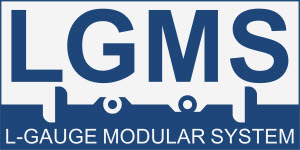 https://lgms.org/
https://lgms.org/ Some of the non-Lego manufacturers and suppliers I have come across are:
- Bricktracks
- Brick Train Depot
- Lifelites
- Brick Model Railroader
- OK Brickworks
- Trixbrix mostly Lego Compatible track, switches, lit signals, and accessories
- Buildamoc
- CaDa
- The Drift Art Co
- Fun Whole
- Goirzi
- Jie Star
- Kazi
- Lepin
- LIDL Supermarkets
- Mould King
- Zhegao
- https://www.usablocks.com/ They offer a WIDE range of models, and have A LOT of train offerings
- My Building Blocks Shop Supplier located on the U.S. West Coast
- Your World of Building Blocks Chinese Supplier for multiple manufacturers (like Mould King, Jie Star, and Goirzi)
- Building Toy Store Chinese supplier for multiple manufacturers, with excellent English!
- https://www.ebay.com/str/bricksmyheartvarietystore Something like 75 pages of -non- Lego brick models!
- https://buildiverse.com/ Mostly well detailed models of Japanese buildings and garden scenes except for one monster
IMPORTANT NOTE: Keep in mind, that the offerings from the Chinese manufacturers may be short production runs, so, if you're looking for some of these items I have mentioned on this page, this page was originally done in early 2023, and the kits may not be available when you go looking for them. I have not provided links to the sellers pages on EBay, but you can do a search by the sellers name to see what they currently have offered, if anything.
Track. The track the models ride on requires a section all to itself. The out of the box track that Lego supplies are in 5 inch sections for the straight pieces, and R40 radius for the curved sections. 40 refers to the radius, measured in the number of studs. You will find that R40 track sections are really only usable for their short-wheeled base intercity trains, trams, and trolleys. Track is also available in R56, R72, R88, and R104 radius' from other vendors.
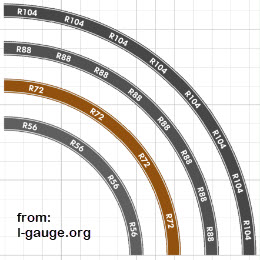
Couplers. Standard Lego couplers are magnetic, and I have seen 20+ car trains being pulled by two locomotives at the train shows with no problem. There is someone who makes a transition piece, so you can use standard "O" Scale couplers - I'm looking for info on them.
Trucks/Boogies. There is a lot of variety here, especially from non-Lego manufacturers. I have only seen diesel locomotives, passenger cars, and freight cars offered with one and two axles. If you want an "SD" style truck with three axles, you will have to roll your own.
As you go through these pages, I will be dealing with standard Lego bricks, and not the larger DUPLO size, or the smaller "mini" or "micro" sized blocks -- this is because the Lego trains are only "done" in the standard sized Lego blocks with very few exceptions in the Duplo series. If you are into building some of the architectural series type "stuff", you will notice that they are done in the mini sized bricks, especially the beautiful Chinese gardens with 3,000 brick sized builds.
Often, a lot of sellers on EBay will split up a set, and offer you the un-built or already built cars and engines separately from the boxed set. While it may seem wrong to split up a set, it does give you the opportunity to fill-in a set that may be missing a certain piece, or maybe you want to add to that in a string of freight cars. Here is one example:
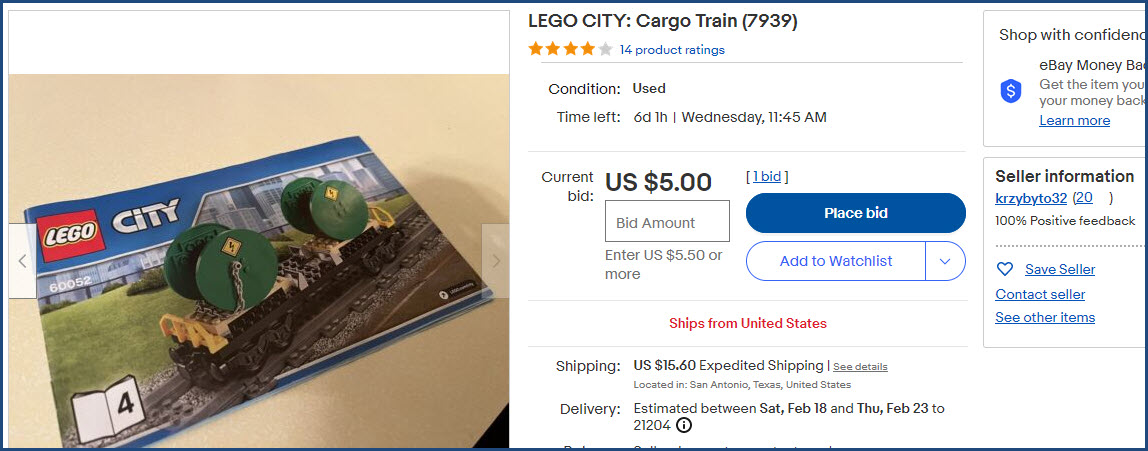
Acknowledgements:
Denver Todd
lego.com
Google Search
Ebay
Websites and other additional information sources of interest:
http://l-gauge.org/wiki/index.php/Welcome_to_L-Gauge
http://www.lego.com
https://www.bricks4kidz.com/
https://www.bricks4kidz.com/blog/the-anatomy-of-a-lego-brick/
https://www.brickfanatics.com/
https://www.instructables.com/How-to-Build-an-Elevated-Toy-Train-Track-Around-a-/?utm_source=newsletter&utm_medium=email
https://jaysbrickblog.com/
The next reference page needs a special mention because on it, are multitude of ways to make track look more realistic, and tucks/boogies to look like the real thing.
https://l-gauge.org/wiki/index.php?title=Reference_Instructions&fbclid=IwAR0skOmjnl5kO2Gzg2UBpcwiQOwpn_YzbS5MEOkjMMkd3vAh2weR-lrfW1E
This section is for beginners, if you're already building anything with Lego Bricks and are familiar with the info presented here, you can skip this page.
Lego style building blocks are/were available in five different sizes.... The standard size ones that almost every Lego set is designed around, a larger size called DUPLO (the blocks are twice the dimensions), and for a while back in 2004-2006, QUATRO size Bricks (Quatro meaning four times the size, and quatro in Spanish means four). Going the other way into the smaller sized realm, there are Mini Bricks and Micro Bricks.
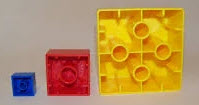 Regular, Duplo, and Quatro sized Bricks
Regular, Duplo, and Quatro sized BricksReally Basic Basics, By The Numbers
If you're just starting out building things with Lego style Bricks, it helps to know what to call things and how you refer to them when talking about Lego's with other people. Here is a quick rundown....
1) Studs
Studs, those little bumps all over Bricks, Baseplates, and so on. They are the reason all of this stuff works. They are designed to precisely mate with "the other side" of mating Bricks, Tiles and accessories. The friction between the Studs and the other piece is what keeps all of our beautiful creations together. You can easily tell if what you are using is genuine Lego, because all the Studs are embossed with "LEGO". Some of the 3rd party manufacturers mark their Studs in a similar manner (CaDa is one of them). If you're getting into Lego trains, most involved with the hobby like to see everything made by Lego, unless Lego does not make specific pieces, like wide radius curved track sections.
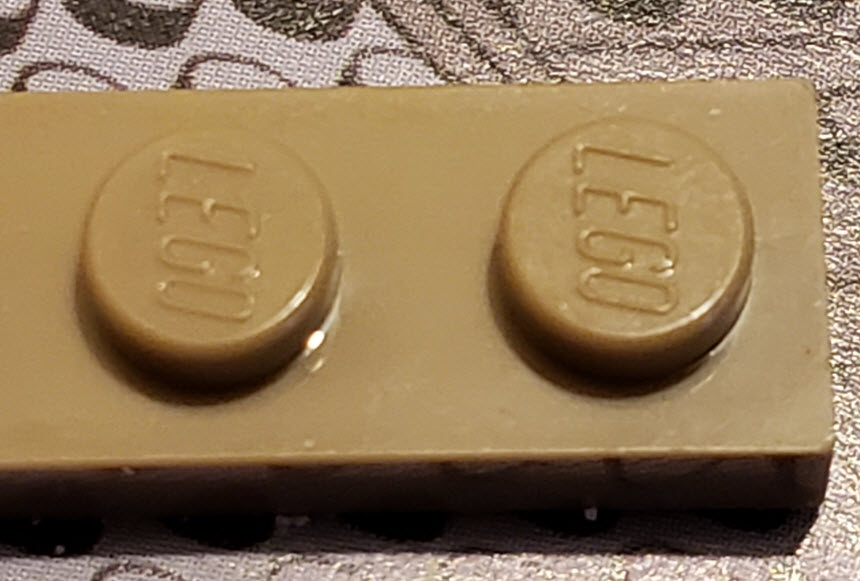
2) Elements
Before we get too far into describing the various parts, I need to mention this: If you hear someone using the term "ELEMENT", they are referring to a Lego piece like a Brick or Tile.
3) Blocks or Bricks?
The basic building element is the BRICK - what most of us would call a block, but shouldn't (it's as bad as calling a hard core Star Trek fan a "Trekkie", they're not, they are "Trekkers").
Bricks come in a wide variety of sizes. Most sizes in the Lego world are given by the number of studs, and their thickness. The smallest Brick is a 1x1 with one stud on the top. If you're talking about a standard single height Brick, they are referred to as a 1x2 or a 2x3 Brick, indicating the number of studs on top. If they are taller, or thicker, a third dimension is used, such as a 2x2x3, indicating that the Brick is "3 high". The largest size Brick commonly available is a 2x16.
- Studs are on 8mm centers
- Studs are about 4.5mm in diameter
- A single width brick is 8mm wide, so,
-- a 1x1 is 8mm by 8mm by 9.5mm thick/tall in size,
-- a 2x8 would be 16mm wide and 48mm long,
-- and a 1x2x3 would be 8mm by 16mm and 28.5mm thick/tall.
Single thickness bricks will be referred to as a (for instance) 1x10 or 2x3.
Thicker bricks will be referred to as a (for instance) 2x2x3.
All Lego parts are made of ABS - Acrylonitrile Butadiene Styrene - which is an industrial strength plastic used to make all sorts of things like interior car parts and anything else that requires durability and strength.

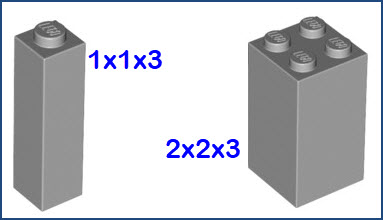
Here are some examples of standard bricks (prices current as of MAR2023):
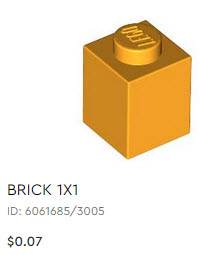
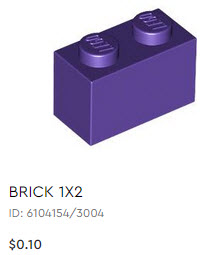
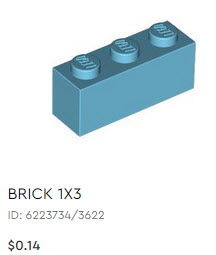
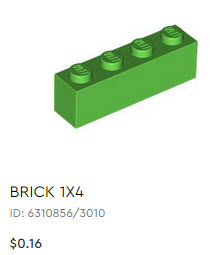
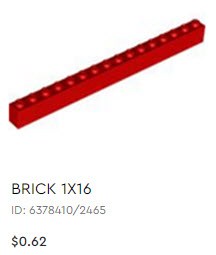
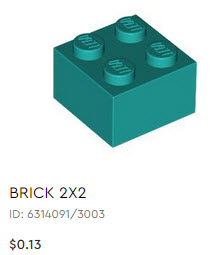
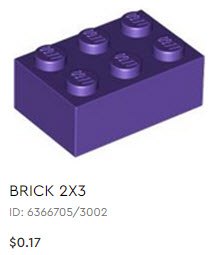
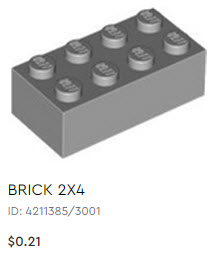
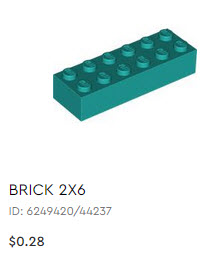
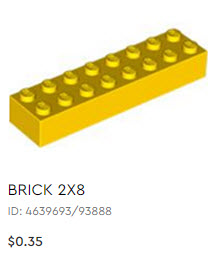
4) Baseplates
BASEPLATES are what many projects are built upon - things like buildings, farms, and street scenes to name but a few. The standard size for a baseplate is 32x32 studs, which works out to 10x10 inches. It looks like Baseplates come in green, grey, blue, white, and brown. There are smaller Baseplates such as 8x16 and 8x8, Lego makes a larger 48x48 Baseplate (15x15 inches), but it looks like it is only available in gray. (Quick English lesson on the use of gray/grey - both gray and grey are correct, however, gray is mainly used in the United States, while GREY is used everywhere else, and that's why on the Lego website, it is GREY). Baseplates are much thinner than standard Lego elements, and are vacuum formed instead of being molded. The bottoms of Baseplates just have dimples where the studs are above. Another big use of base plates, if you are building a city scene, is for giving your vehicles a place to drive on :-). There is a whole series of Baseplates made for city scenes that have various configurations of streets and crossings on them - a small selection is shown below.
Standard colors are green, grey, blue, and white. There are quite a few special base plates out there, but most are made by manufacturers other than Lego.
The standard sized Baseplates from Lego are about $8 at retailers and Lego. Walmart carries gray and green Baseplates for around $3.50, while over at certain Dollar Tree's (the bigger ones), you may be able to find the 32x32 gray Baseplates for $1.25. Brickloot offers the 48x48 Baseplates in green and gray, four for 40 bucks.
If you're building a MODULAR Lego train set, and plan on sharing it with others at meets, base plates are the basis for the LGMS standards.... Minimum size for a module is 3x3 (10"x10" base plates). Lengths (as the tracks run) need to be in multiples of 3, the depth can be added in widths of one. So from a basic 3x3 module, the next larger size (in both dimensions) would be a 6x4.
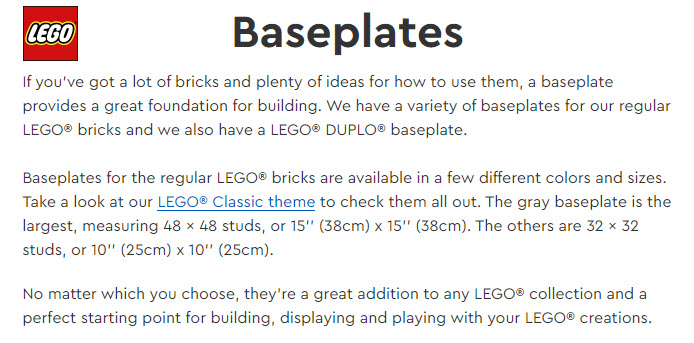
Lego may halt the production of Baseplates, according to information floating around on the internet, will they? We'll see.....

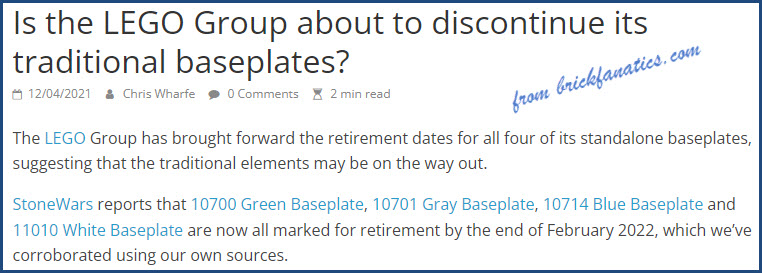
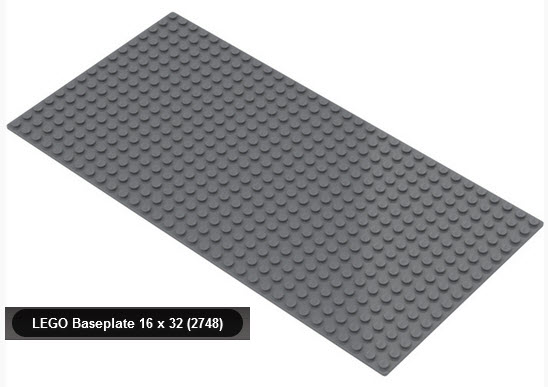
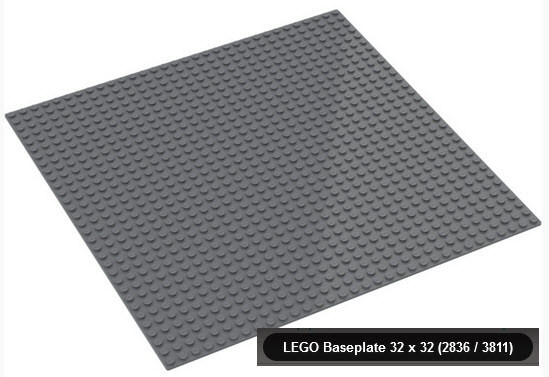

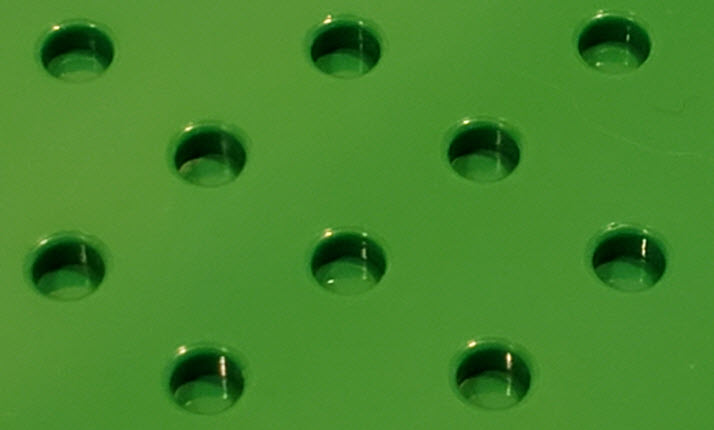 The bottom side of a Baseplate.
The bottom side of a Baseplate.Typical City Scene Base Plates:
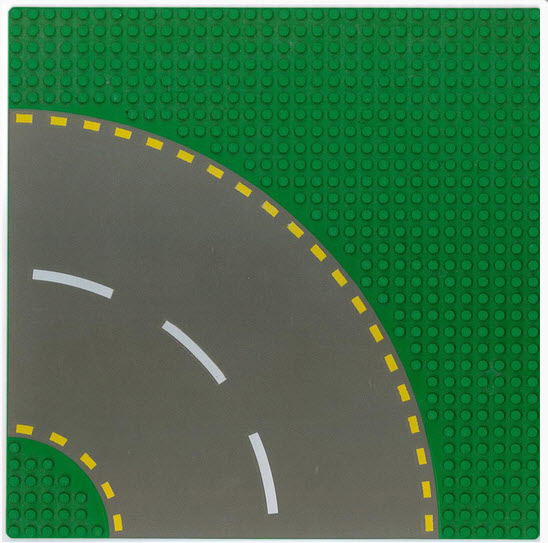
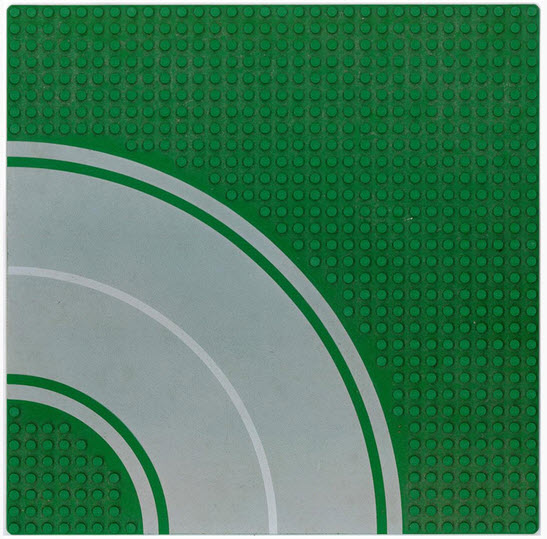
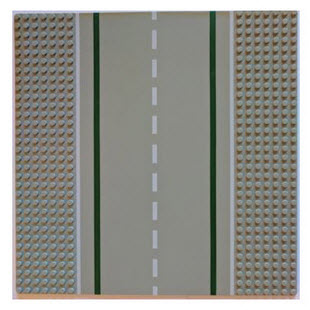
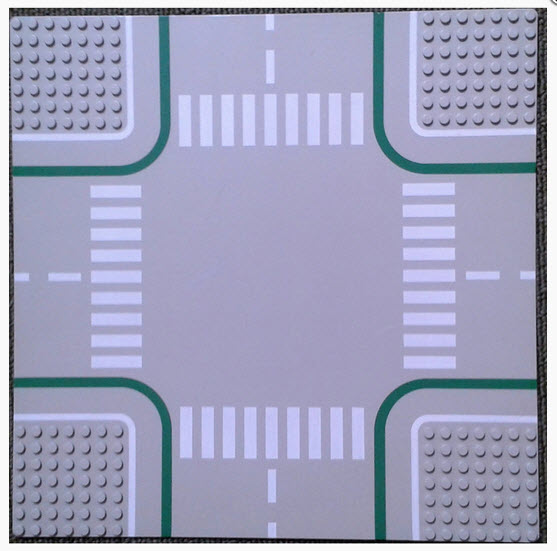
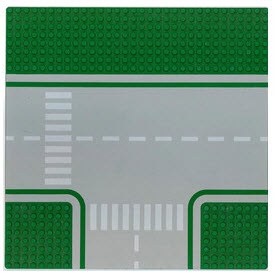
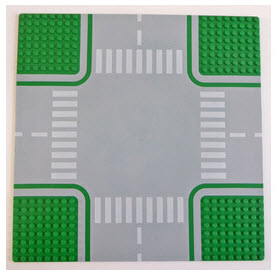
5) Plates
A PLATE is a Brick that is 1/3 the height of a standard Brick. If you stack three of them on top of each other, they will be as high as a standard Brick - like the tan/pink/blue ones below compared to the single height 1x2 red Brick.
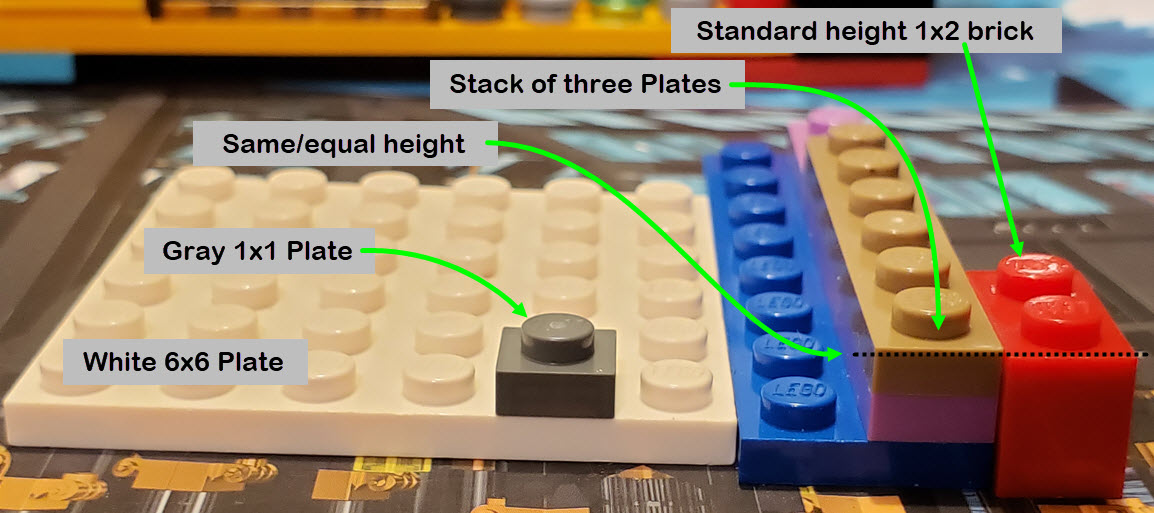
6) Tiles
TILES are special bricks which have a smooth surface on one side, and are used for finishing a surface to improve the appearance of whatever it is attached to. They can be used to make a nice looking table top; or, a smooth surface to put decals on; or, in the case of Lego trains, covering base plate studs to put curved track sections and turnouts on (among MANY other uses). They attach to the Studs of Bricks, Plates, or Baseplates.
Tiles can be as small as a 1x1 or smaller in the case of a quarter-round curved piece. Many come decorated for special applications. A lot of them made for trains (and cars and trucks) have gauges or speedometers on them.
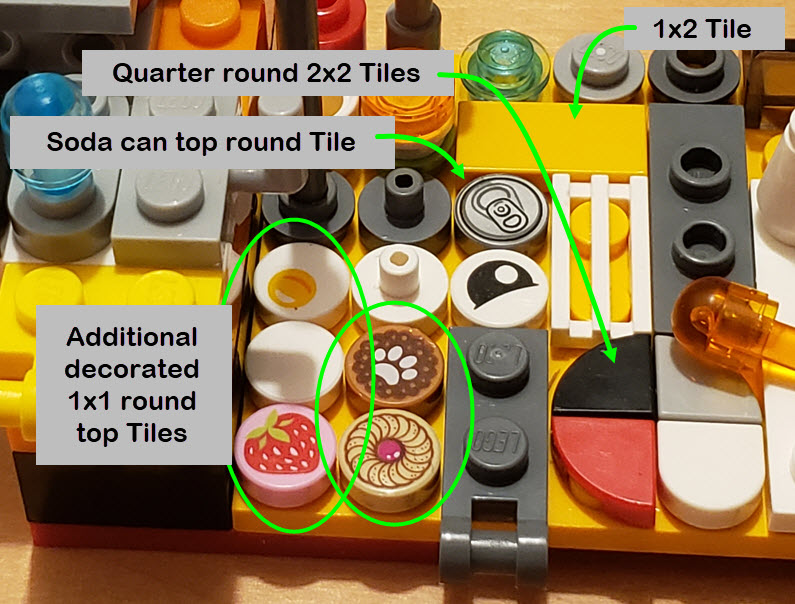
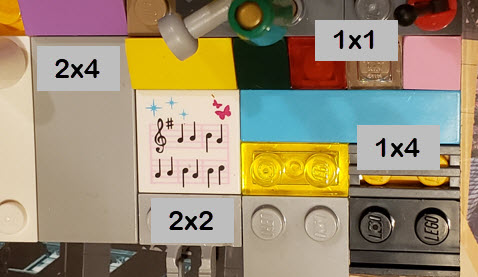
If you're building a model using Technic Bricks, and need to put a Tile on the side of it, they will often use a special pin that allows you to do so without a lot of "fuss and muss" - the green part will go into a hole in the side of a Technic Brick, and what's left protruding (the white part), will be where you attach the Tile. Compare this pin to the standard Technic connecting pin (black). Sometimes designers will sneak a Technic Brick into a regular build so a (for instance) a picture can be "hung" on a wall, like the musical Tile above :-).
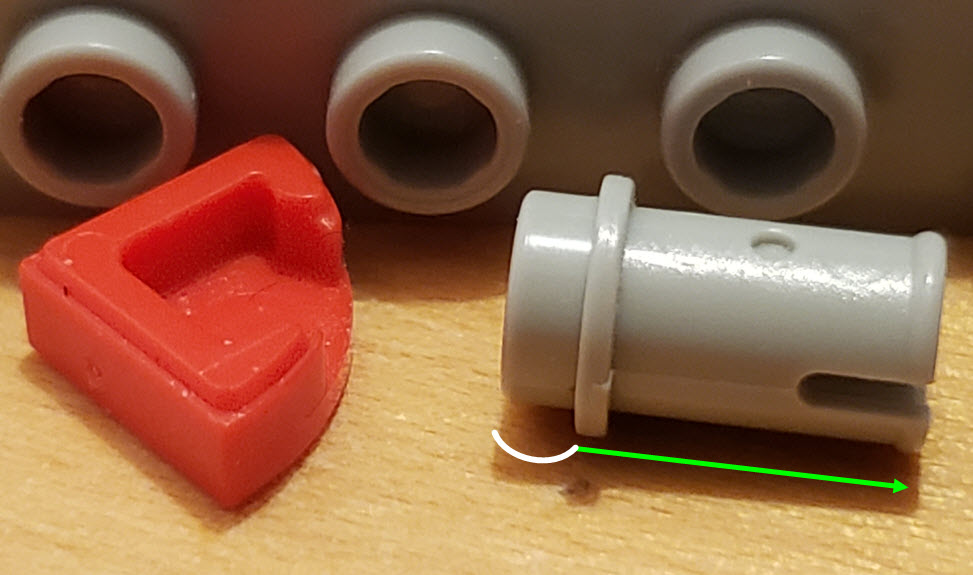
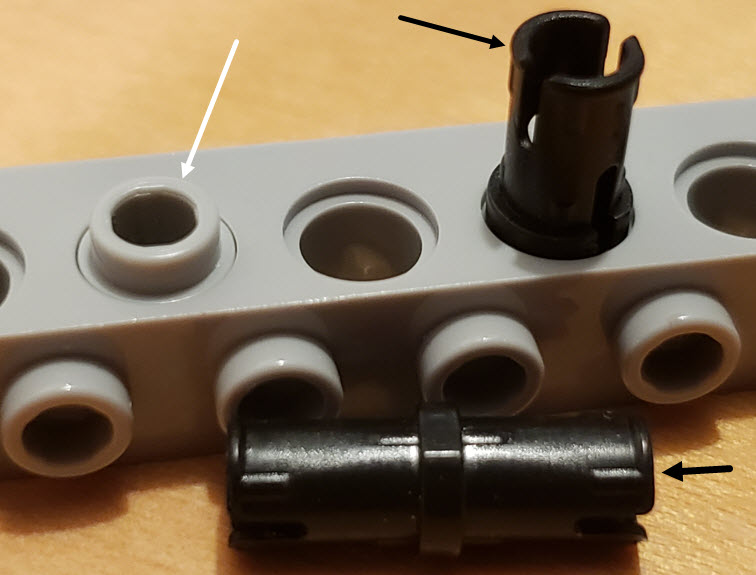
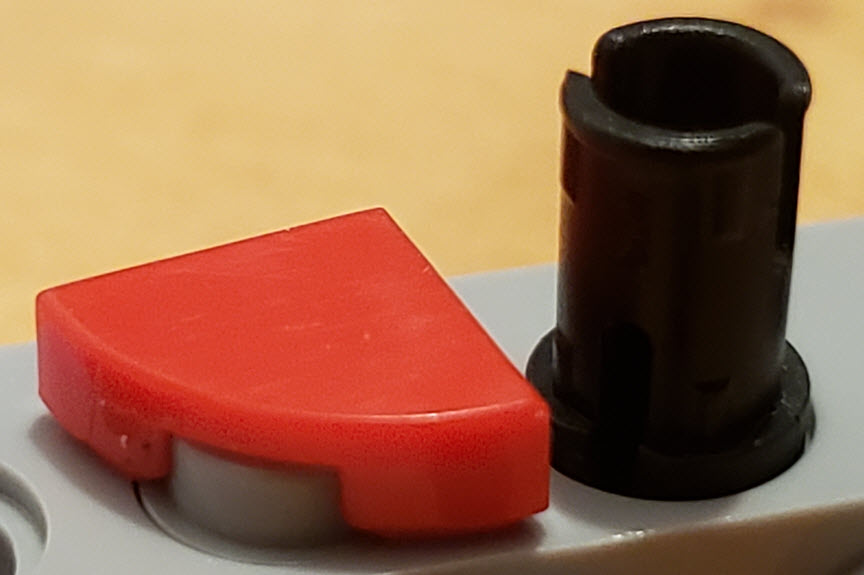
7) Jumper Plates
I'm going to borrow the description for these Bricks from the bricks4kidz page, because it couldn't be said any better: A JUMPER PLATE is a Plate that has only one stud in the center. Itís typically used for half-stud offset building, which basically means itís used in cases where a builder wants the freedom to create without being confined by the standard alignment of studs on traditional Plates and Bricks. Shown below are 1x2 and 1x3 Jumper Plates, notice how the studs are offset by half a space. Also notice how there are four (4) ever-so-slight flat surfaces on the inside of the stud (black arrows), so you can insert a standard sized dowel (or other part) without having it slip or fall out - as can be seen in the second photo.
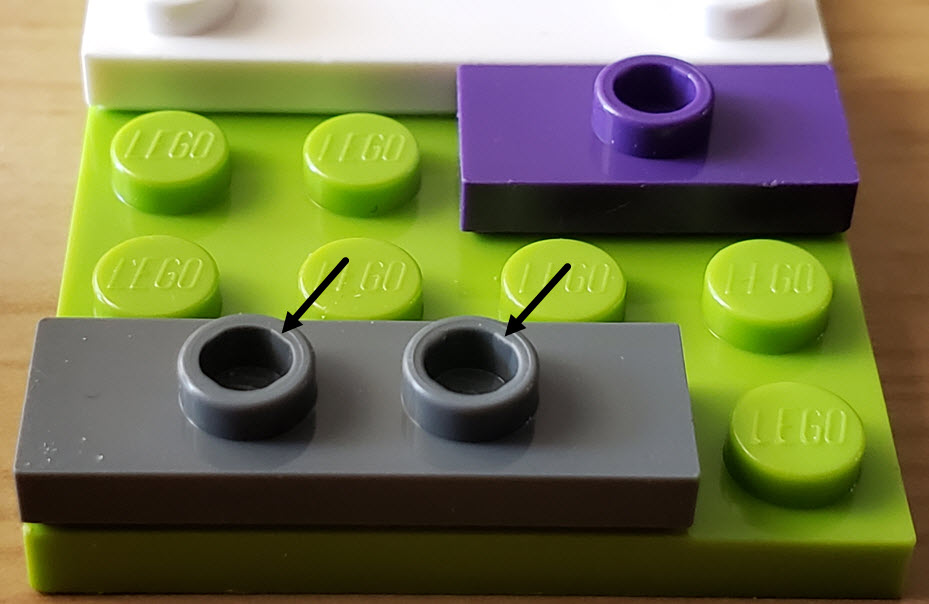
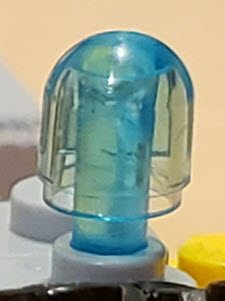
Colors
Below are three versions of the color chart from the Lego "pick a brick" page.
In addition, there is another color chart I found on FB where the person used the actual color bricks.... pretty cool!
The info is current as of March 2023.
The first chart is a screenshot of the page and the colors are alphabetically listed, along with the quantity of each offered in that color.
None of the colors are offered in all of the shapes Lego bricks come in except for maybe white. White seems to lead the pack with 52 variations,
Some colors, such as warm gold and transparent bright violet, only come in one variety.
The other two charts are my adaptation with the associated colors, with one grouped by color groups:
Lego's Pick A Brick page
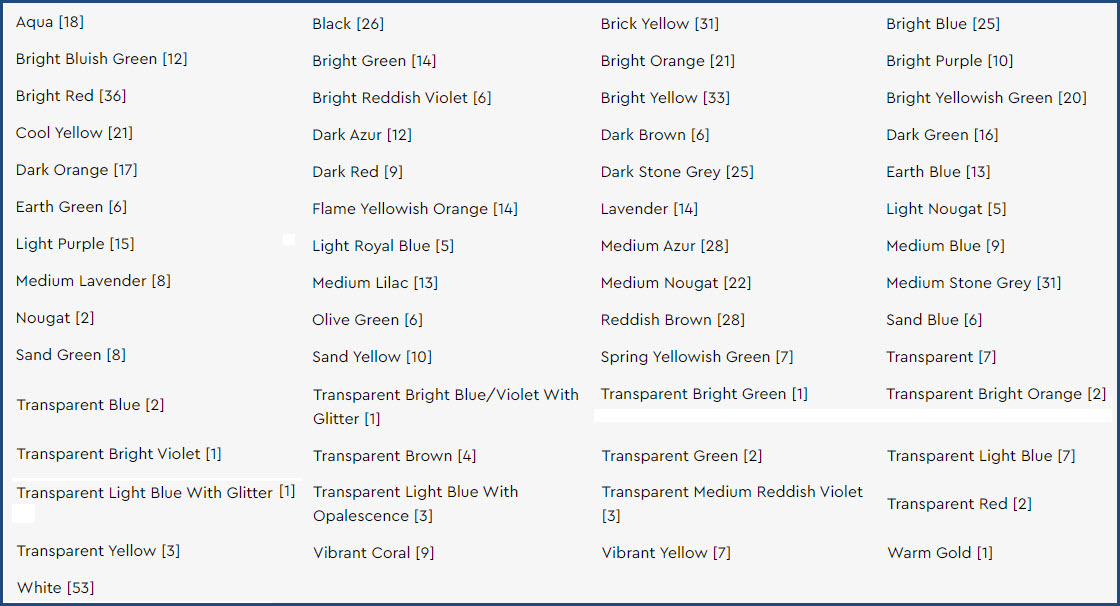
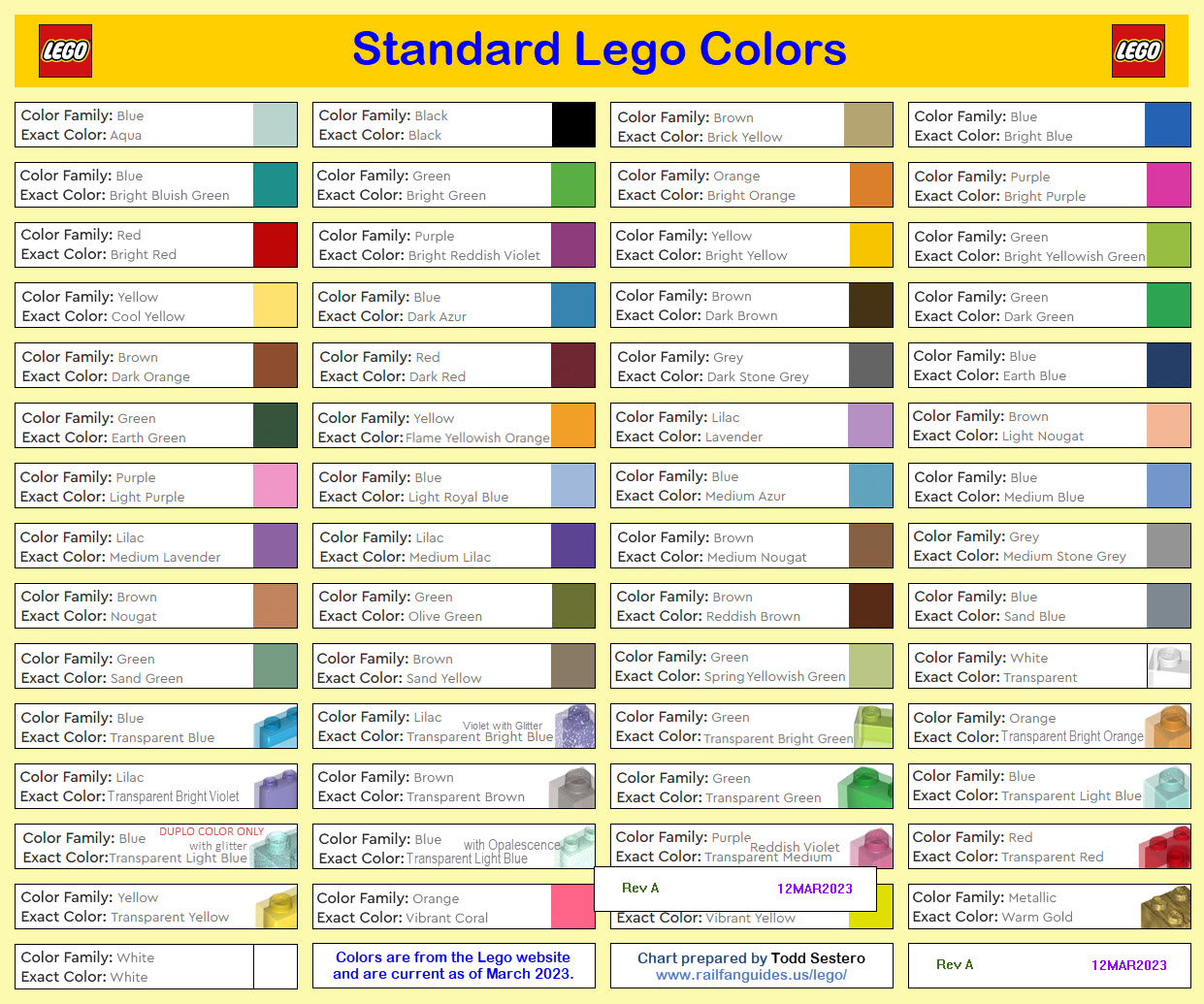
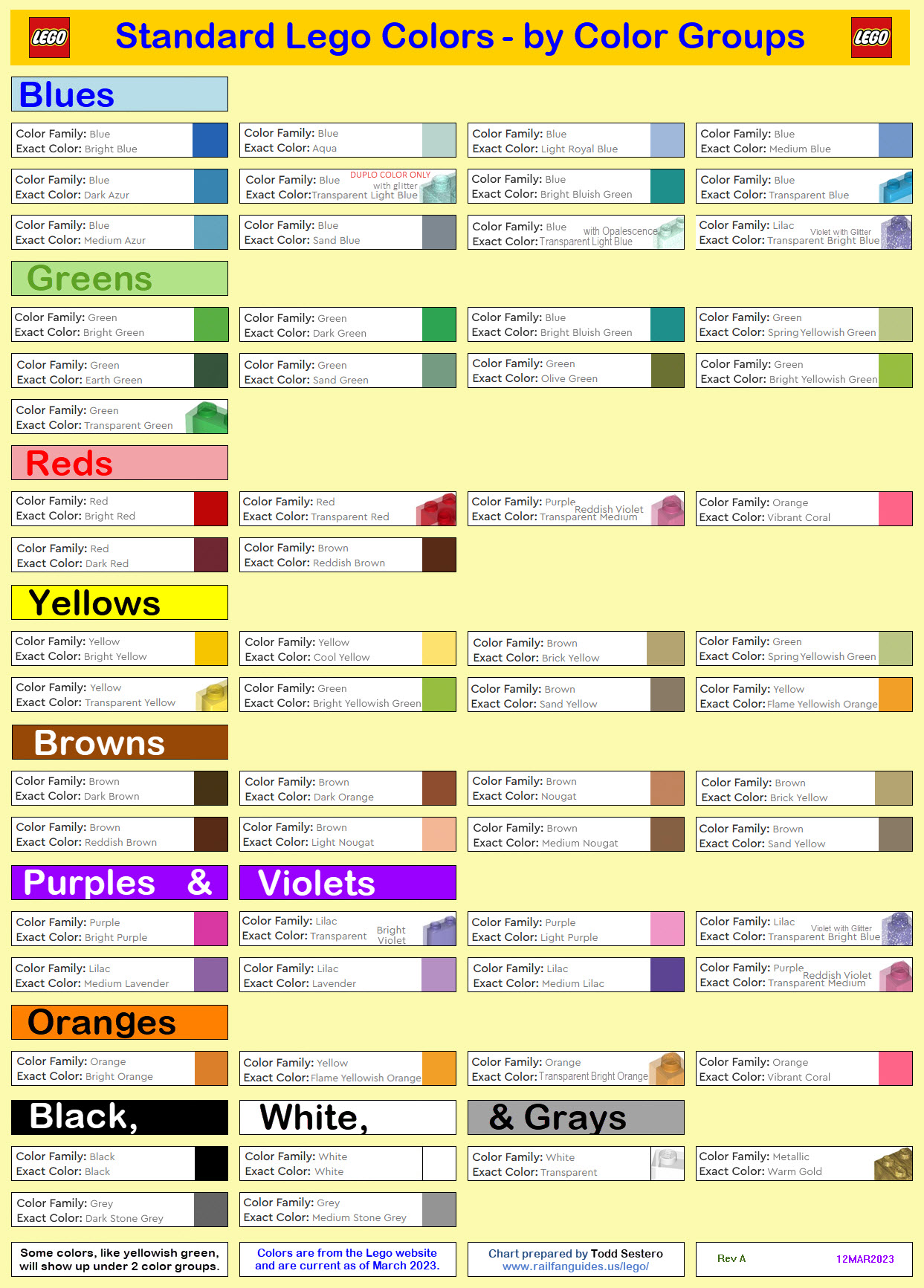
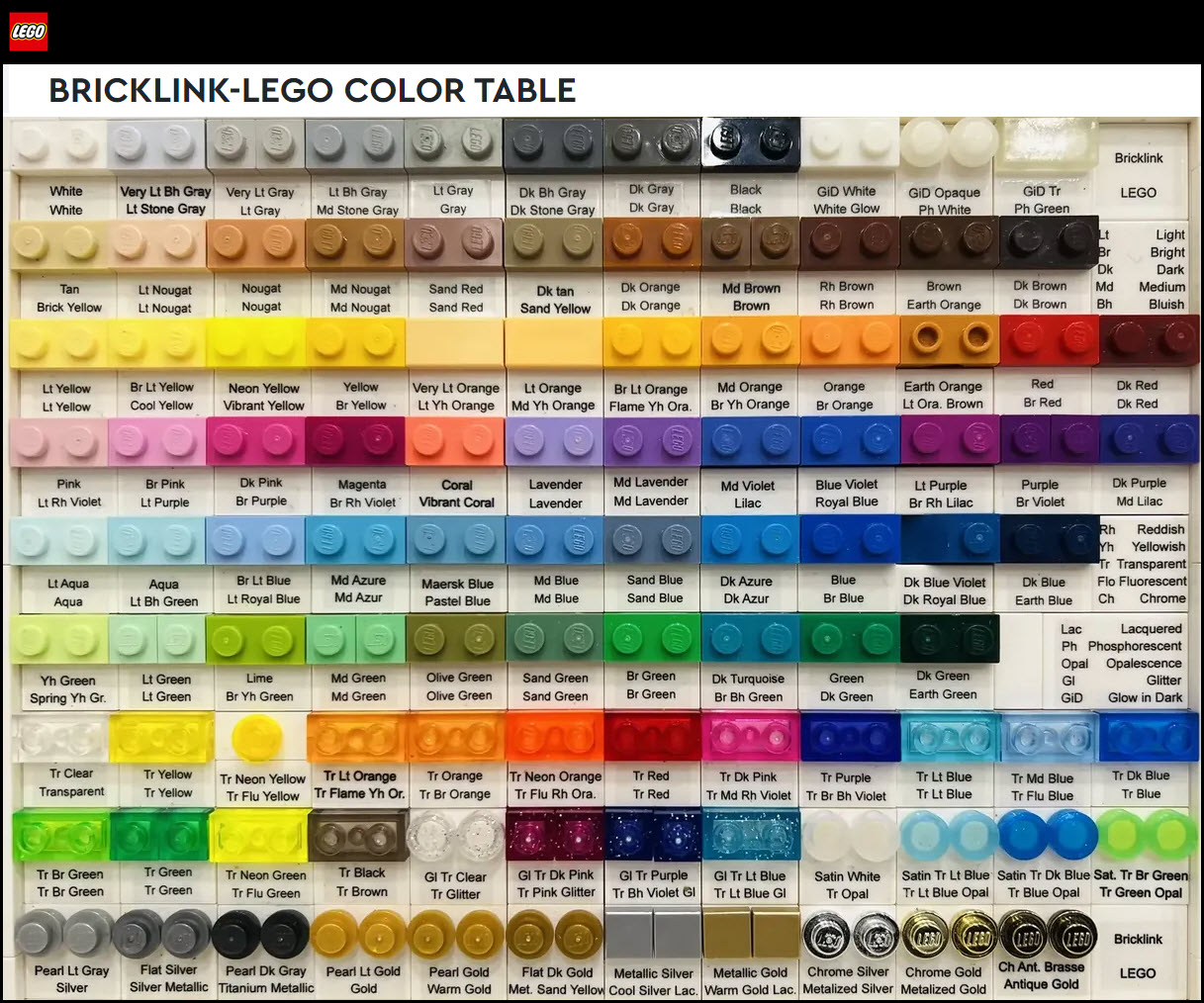
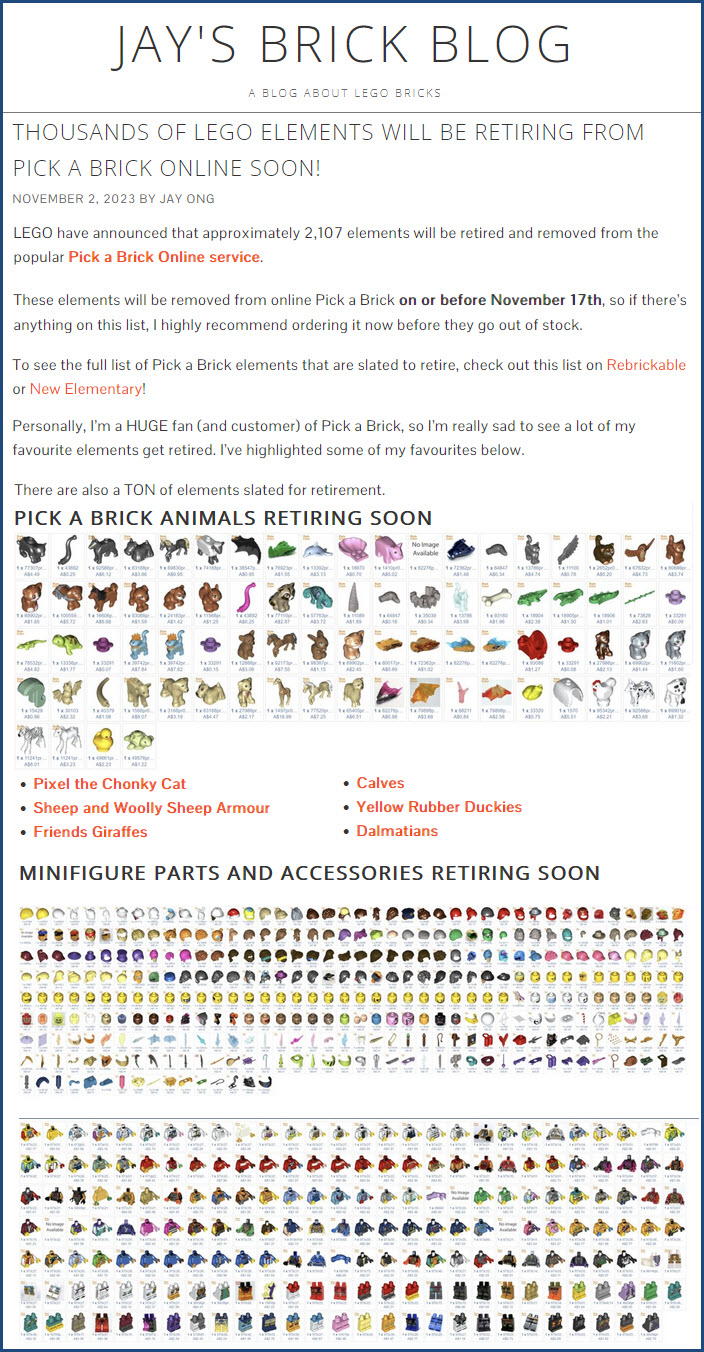
Disclaimers:
New format 10/26/23: Please check out my disclaimer page for my standard dribble and contact info here
RAILFAN GUIDES HOME
RAILROAD SIGNALS HOME
NEW MAR01/2023, MAR20/24/2023, NOV04/07/2023, DEC14/2023, MAR07/2024, NOV29/2024
Last Modified 29-Nov-2024